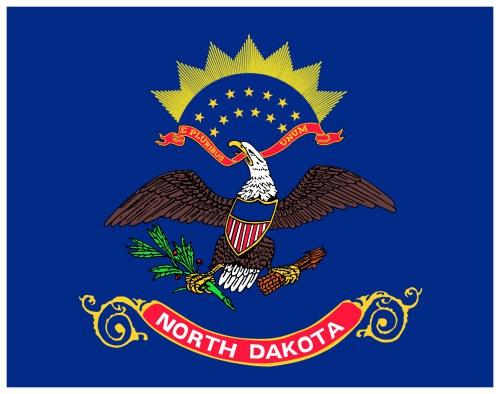
Flag of North Dakota, USA
February
Weather in February
February continues the trend of cold weather in North Dakota but often sees a slight increase in temperature compared to January. The minimum temperatures can range from -8°F (-22.2°C) to 18°F (-7.8°C), with maximum temperatures typically ranging from 10°F (-12.2°C) to 28°F (-2.2°C). Snow remains a prominent feature, with February maintaining the winter's persistent snowpack.
The weather conditions in February are similar across the state, without significant variations between cities. Arctic air masses continue to influence the climate, bringing cold temperatures and occasional snowstorms that can disrupt travel and outdoor activities. While the extreme cold of January may begin to lessen, February still presents a significant number of days below 0°F (-17.8°C), especially in the northern regions of the state.
Compared to January, February marks a gradual transition towards the end of the winter season. The increase in temperature is slight, and the overall weather pattern remains consistent with the previous month. The cold and snowy conditions persist, providing continued opportunities for winter sports enthusiasts. As the month progresses, there might be early signs of spring, but the winter weather largely dominates the landscape and daily life in North Dakota.
The weather conditions in February are similar across the state, without significant variations between cities. Arctic air masses continue to influence the climate, bringing cold temperatures and occasional snowstorms that can disrupt travel and outdoor activities. While the extreme cold of January may begin to lessen, February still presents a significant number of days below 0°F (-17.8°C), especially in the northern regions of the state.
Compared to January, February marks a gradual transition towards the end of the winter season. The increase in temperature is slight, and the overall weather pattern remains consistent with the previous month. The cold and snowy conditions persist, providing continued opportunities for winter sports enthusiasts. As the month progresses, there might be early signs of spring, but the winter weather largely dominates the landscape and daily life in North Dakota.
- Fargo - February »
In Fargo during February, snow falls for 12.9 days and regularly aggregates up to 3.7" (94mm) of snow. In Fargo, in February, during 1.7 rainfall days, 0.63" (16mm) of precipitation is typically accumulated. - Bismarck - February »
The month with the most snowfall is February, when snow falls for 15 days and typically aggregates up to 4.33" (110mm) of snow. The month with the most snowfall in Bismarck is February, when snow falls for 15 days and typically aggregates up to 4.33" (110mm) of snow. - Grand Forks - February »
The months with the lowest UV index in Grand Forks are January, February, November and December, with an average maximum UV index of 1. January and February, with an average relative humidity of 91%, are the most humid months in Grand Forks, North Dakota. - Minot - February »
The month with the least rainfall in Minot is February, when the rain falls for 1.3 days and typically collects 0.39" (10mm) of precipitation. In Minot during February, snow falls for 11.3 days and regularly aggregates up to 2.76" (70mm) of snow. - West Fargo - February »
In West Fargo in February, it is raining for 1.7 days, with typically 0.63" (16mm) of accumulated precipitation. In West Fargo, in February, during 12.9 snowfall days, 3.7" (94mm) of snow is typically accumulated. - Williston - February »
In February, in Williston the rain falls for 3.1 days. In February, in Williston it is snowing for 12.3 days. - Dickinson - February »
In Dickinson in February, snow falls for 11.9 days, with typically accumulated 3.03" (77mm) of snow. The months with the least sunshine in Dickinson are January and February, with an average of 4.4h of sunshine. - Mandan - February »
In Mandan in February, during 11.1 snowfall days, 3.19" (81mm) of snow is typically accumulated. In Mandan during February, snow falls for 11.1 days and regularly aggregates up to 3.19" (81mm) of snow. - Jamestown - February »
In Jamestown during February, snow falls for 11.6 days and regularly aggregates up to 3.78" (96mm) of snow. In Jamestown in February, it is raining for 1.6 days, with typically 0.59" (15mm) of accumulated precipitation. - Wahpeton - February »
January, February and December, with an average maximum UV index of 1, are months with the lowest UV index in Wahpeton, North Dakota. February's Weather in Wahpeton, North Dakota, still reflects winter tendencies with temperatures marginally increasing compared to January. - Devils Lake - February »
The months with the least rainfall in Devils Lake are January and February Rain falls for 2.2 days and accumulates 0.43" (11mm) of rain. The months with the lowest UV index in Devils Lake, North Dakota, are January, February, November and December, with an average maximum UV index of 1. - Valley City - February »
In Valley City, North Dakota, during February, snow falls for 12.2 days and regularly aggregates up to 3.07" (78mm) of snow. In Valley City, North Dakota, in February, it is raining for 1.8 days, with typically 0.47" (12mm) of accumulated precipitation.
Updated: May 24, 2024
Published by: Weather Atlas | About Us
Data Sources | Weather Forecasting & Climate
Published by: Weather Atlas | About Us
Data Sources | Weather Forecasting & Climate


